Understanding Copyright: An Overview
Copyright is a complex issue, with many facets to get your head around. But it’s essential for photographers to have an understanding of it, and the surrounding licensing issues. Explaining every part of copyright law would take far more than a single article, but I’m going to cover some salient points that should hopefully prove useful.
By the way, if you want to read up on copyright further, and get some useful templates into the bargain, I recommend this great book called Beyond the Lens published by the Association of Photographers.

photo by Dennis Skley
The term copyright broadly describes something (in this case, your photo) that is your intellectual property and is something you’ve created. This legal tool is there to stop other people taking your work and using it as their own or making changes to it.
You automatically hold the copyright to a picture you take, but you can’t copyright an idea – i.e. someone can go out and take the same photo as you. Generally artistic copyright lasts for 70 years from the end of the year in which the person who created it dies. After this, the work will most likely become ‘public domain’.
Model Release Forms
If you photograph a person (e.g. a model) and want to sell the image, you’ll need your subject to sign a model release form giving you permission to use the photograph. There are a variety of simple templates available that you can copy and adjust to your own personal requirements.
Also known as a liability waver, the release gives permission to publish the image whereby the subject could otherwise have their personality or privacy rights infringed. In general, however, no release is needed if a person is in a public place and photographed for publication for news.
Royalty Free
A common misconception with royalty free is that people believe they can just use the image for whatever they want without paying. Actually, Royalty Free means that you must pay the licence once for an image, but that you can then use it multiple times without paying again.
Licensing to Clients
It’s up to an individual photographer what license they grant to different companies, but it is important to define these rights. Otherwise, you could find that a commercial client is using your imagery in perpetuity, without you making any money apart from your initial fee.
In general, I recommend that, in addition to charging a fee for your shoot, you also consider granting a license for the company in question to use your images exclusively for a year to two years in their advertising. Obviously, you can negotiate and ‘tweak’ this license as necessary and renegotiate a fee after the time is up for continued usage.
You can also break licensing down into further categories:
- Commercial Rights: This is fairly simple to understand – a person or company buys your photographs to use in a brochure, catalogue or another form of advertising for commercial purposes.
- Non-Commercial Rights: This gives the client the right to use your image for non-commercial endeavours such as personal websites, newsletters, blogs and really anywhere that isn’t a moneymaking endeavour.
- First Rights: Applying to magazines, you give the publication permission to be the first to use the image, but retain the right to resell the photo at a later time. Most publications will ask for around six months to a year’s exclusivity.
- Serial Rights: Again applying to magazines, serial rights give the publication exclusive permission to use the image. However, this means that you cannot resell the image at a later date.
- One Time Use: This is a great form of licensing for a photographer, as you’re selling the person or company the right to only use your image one time for one specific purpose.
- Rights Managed: This is a more complicated form of licensing, whereby images have specific restrictions on use and different fees associated with each different use. You can also give various levels of exclusivity, and your client can also request limited exclusivity for the image if they want to prevent competitors from using it.
Although this is by no means a complete description of all the issues and rules surrounding copyright, this article will hopefully give you a broad overview and help you to start to understand how to protect your work. P.S.: don’t forget to put a watermark on your website images!
